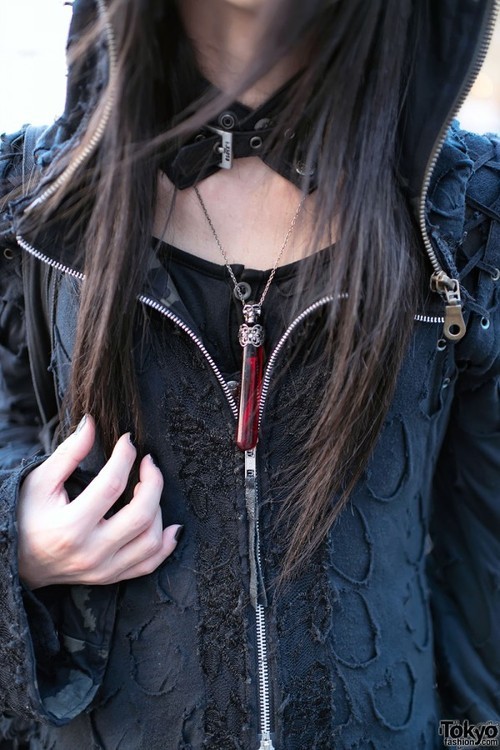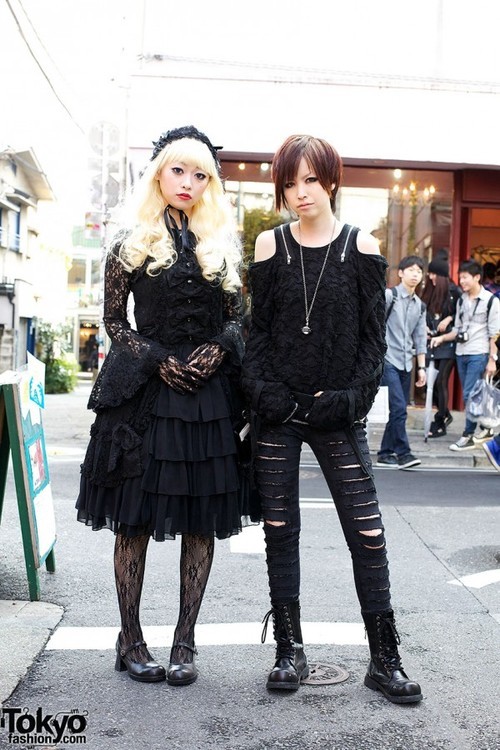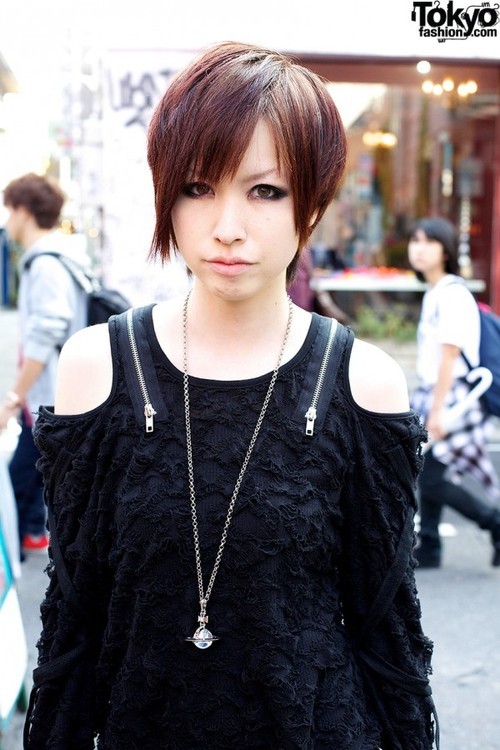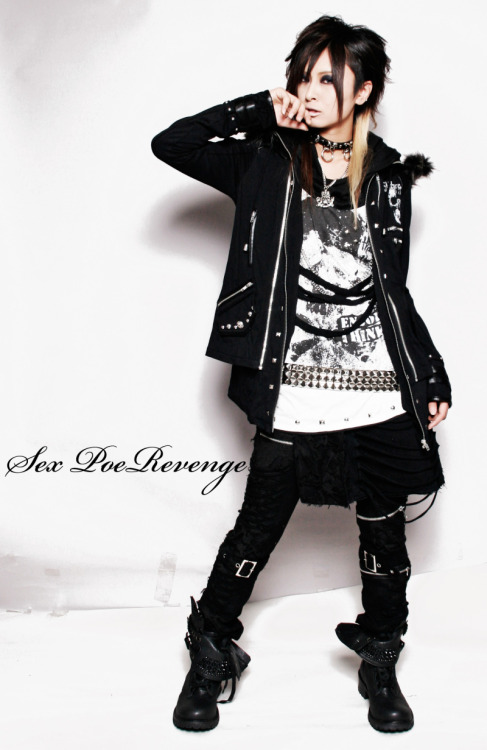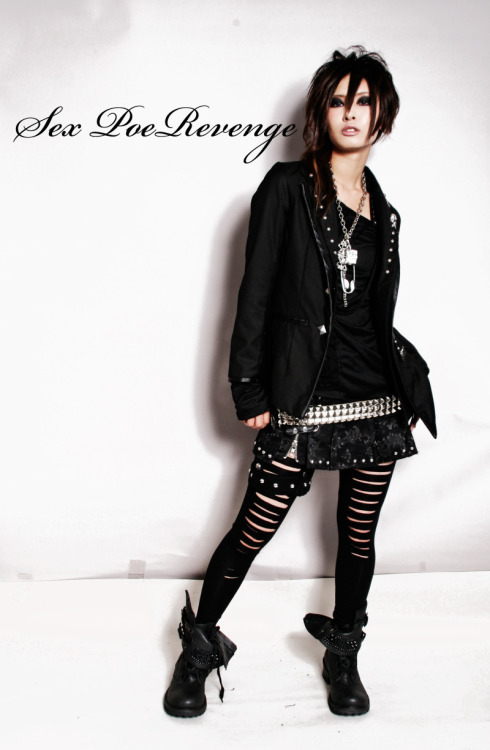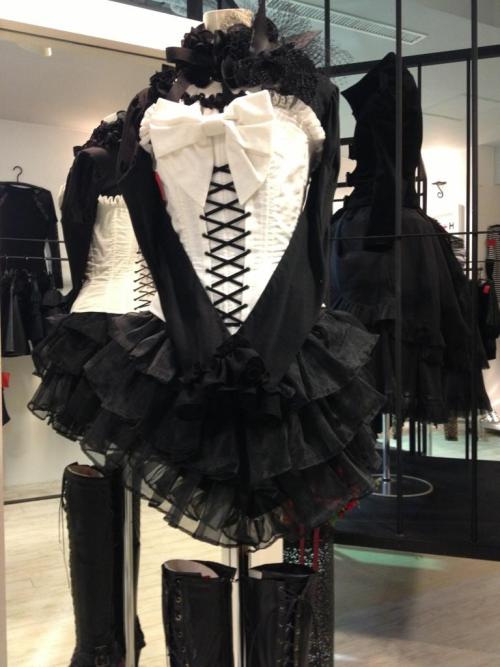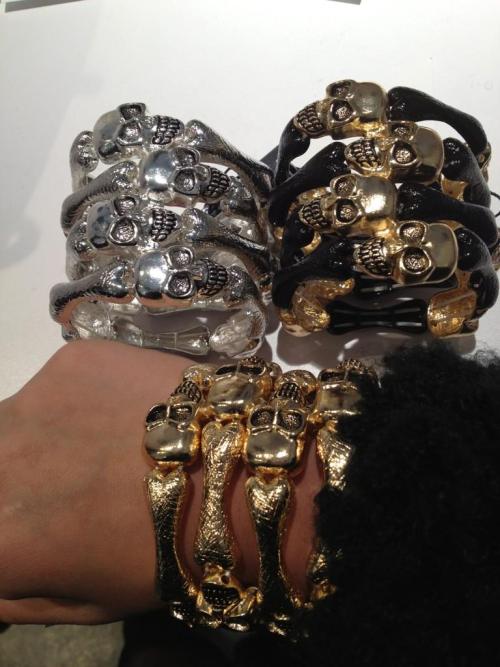#visual system
Ruru is a super friendly 18-year-old Harajuku girl with a gothic sense of style who we’ve snapped several times before (back in August andSeptember).
Ruru is wearing a matching t-shirt and hoodie from Hangry & Angry, both with creepy and cute prints. Her black skirt is from h.NAOTO, and so is her backpack. She bought her chunky heeled loafers in Harajuku, and paired them with white, spider web print tights. She also carried a rabbit-shaped bag, with zippers and chains. Her bird cage necklace is BPN and her matching choker and bracelet (which look like Frankenstein scars) are from Spider Rock Web.
We wanted to know Ruru’s favorite fashion brand and she told us it’s h.NAOTO. Her music taste varies from rock to classic to jazz, with Acid Black Cherry as a reference. Find her blog here. You can also follow her on Twitter (where she posts pictures from Harajuku).
Credit to: Tokyofashion.com
Post link
Here’s Kyouka, who we see often around Harajuku, and someone whose dark gothic style definitely stands out of the crowd. You may remember him as a member of the Harajuku Fashion Walk crew.
Kyouka is wearing a beautiful long hooded jacket/outfit from DARK RED RUM (an h.Naoto brand) with Yosuke platform shoes. Accessories include an h.Naoto leather choker, a vial necklace, and a bag from h.Naoto.
As far as music, Kyouka is a big fan of Malice Mizer. For more information on Kyouka, check out his personal Twitter.
Credit to: Tokyofashion.com
Post link
Yukka and Yuki were both wearing gothic all-black outfits when we noticed them in Harajuku. Yukka went for an androgynous look, while Yuki opted for a romantic and feminine outfit. You might recognize Yukka from the modeling work she’s done for various Japanese magazines and fashion brands.
Yukka is wearing a long sleeve top with cutout shoulders and zippers (from Algonquins) paired with torn skinny jeans. Her military style lace-up boots were an online purchase and her bag is Vivienne Westwood. Her accessories are from Bloody Mary and Crazy Pig: silver rings (some with skulls) and a long pendant necklace. Yukka is donning short brown hair, and loves shopping at Algonquins and Ghost of Harlem. Her favorite music is L’Arc-en-Ciel and rock in general, and you can find her on Twitter as @letitrock69.
Yuki is wearing a lace top with bows and a ruffle skirt, both from Metamorphose. She matched them with lace gloves and tights, as well as a lace headband tied with a ribbon under the chin. She has long, platinum blonde hair, rhinestones under her eyes, and blue contacts. She’s also wearing black Mary Janes, and she told us that Alice and the Pirates is her favorite place to shop. When it comes to music, classical is her favorite style.
Credit to: Tokyofashion.com
Post link
Scientists enable a blind woman to see simple shapes using a brain implant
In the article, “Visual percepts evoked with an Intracortical 96-channel Microelectrode Array inserted in human occipital cortex”, published in The Journal of Clinical Investigation, Eduardo Fernández, MD, PhD, from the University Miguel Hernández details how an array of penetrating electrodes produced a simple form of vision for a 58-year-old blind volunteer. The team conducted a series of experiments with the blind volunteer in their laboratory in Elche, Spain. The results represent a leap forward for scientists hoping to create a visual brain prosthesis to increase independence of the blind.
Phosphenes
A neurosurgeon implanted a microelectrode array composed of 100 microneedles into the visual cortex of the blind woman to both record from and stimulate neurons located close to the electrodes. She wore eyeglasses equipped with a miniature video camera; specialized software encoded the visual data collected by the camera and sent it to electrodes located in the brain. The array then stimulated the surrounding neurons to produce white points of light known as ‘phosphenes’ to create an image.
The blind woman was a former science teacher and had been completely blind for 16 years at the time of the study. She had no complications from the surgery, and researchers determined that the implant did not impair or negatively affect brain function. With the help of the implant, she was able to identify lines, shapes and simple letters evoked by different patterns of stimulation. To assist her in practicing with the prosthesis, researchers created a video game with a character from the popular television show The Simpsons. Due to her extensive involvement and insight, she is also co-author on the article.
“These results are very exciting because they demonstrate both safety and efficacy and could help to achieve a long-held dream of many scientists, which is the transfer information from the outside world directly to the visual cortex of blind individuals, thereby restoring a rudimentary form of sight”, said Prof. Eduardo Fernández. He also added that “although these preliminary results are very encouraging, we should be aware that there are still a number of important unanswered questions and that many problems have to be solved before a cortical visual prosthesis can be considered a viable clinical therapy.”
“This new study provides proof-of-principle and demonstrate that our previous findings in monkey experiments can be translated to humans,” said Prof. P. Roelfsema, a co-author on the study. “This work is likely to become a milestone for the development of new technologies that could transform the treatment of blindness”.
“One goal of this research is to give a blind person more mobility,” said Prof. R. A. Normann, also a co-author on the study. “It could allow them to identify a person, doorways, or cars. It could increase independence and safety. That’s what we’re working toward.”
The research team hopes that the next set of experiments will use a more sophisticated image encoder system, capable of stimulating more electrodes simultaneously and to elicit more complex visual images.
This Woman Sees 100 Times More Colors Than The Average Person
When Concetta Antico looks at a leaf, she sees much more than just green. “Around the edge I’ll see orange or red or purple in the shadow; you might see dark green but I’ll see violet, turquoise, blue,” she said. “It’s like a mosaic of color.”
Antico doesn’t just perceive these colors because she’s an artist who paints in the impressionist style. She’s also a tetrachromat, which means that she has more receptors in her eyes to absorb color. The difference lies in Antico’s cones, structures in the eyes that are calibrated to absorb particular wavelengths of light and transmit them to the brain. The average person has three cones, which enables him to see about one million colors. But Antico has four cones, so her eyes are capable of picking up dimensions and nuances of color—an estimated 100 million of them—that the average person cannot. “It’s shocking to me how little color people are seeing,” she said.
Although tetrachromats have more receptors in their eyes, their brains are wired the same way as a person with normal vision. So how can a brain like Antico’s change to see more colors? Like anything else, practice makes perfect, even when it comes to neural pathways.
For years, researchers weren’t sure tetrachromacy existed. If it did, they stipulated, it could only be found in women. This is because of the genes behind color vision. People who have regular color vision have three cones, tuned to the wavelengths of red, green, and blue. These are connected to the X chromosome—men have one, but women have two. Mutations in the X chromosome cause a person to perceive more or less color, which is why men more commonly have congenital colorblindness than women (if their one X chromosome has a mutation). But the theory stood that if a woman received two mutated X chromosomes, she could have four cones instead of the usual three.
Post link






